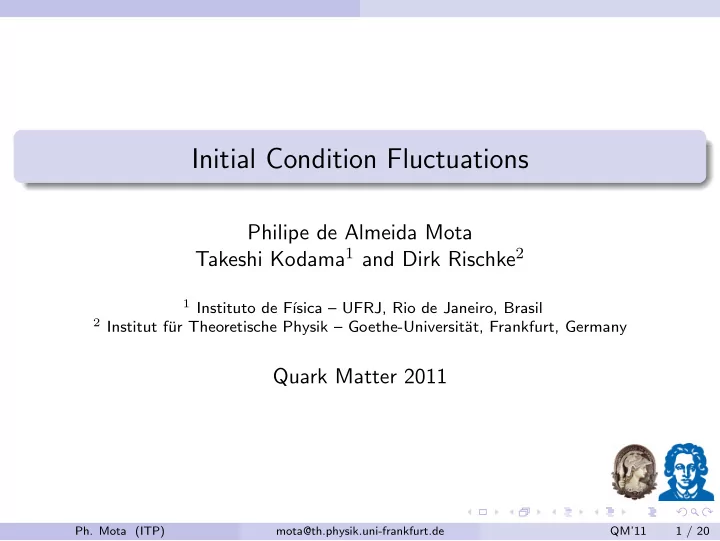

Initial Condition Fluctuations Philipe de Almeida Mota Takeshi Kodama 1 and Dirk Rischke 2 1 Instituto de F´ ısica – UFRJ, Rio de Janeiro, Brasil 2 Institut f¨ ur Theoretische Physik – Goethe-Universit¨ at, Frankfurt, Germany Quark Matter 2011 Ph. Mota (ITP) mota@th.physik.uni-frankfurt.de QM’11 1 / 20
shadow effect hydro IC = smooth BG + gaussian tube → away-side dip final distribution − Ph. Mota (ITP) mota@th.physik.uni-frankfurt.de QM’11 2 / 20
motivation 2-particle correlation @ RHIC from sBG+tube: qualitative behavior no jets purely geometrical Ph. Mota (ITP) mota@th.physik.uni-frankfurt.de QM’11 3 / 20
smooth + fluctuation symmetric BG + fluctuations non-symmetric BG + fluctuations � � f 1 ( φ ) f 2 ( φ + ∆ φ ) � � f 1 ( φ ) �� f 2 ( φ + ∆ φ ) � C (∆ φ ) = d φ − Ph. Mota (ITP) mota@th.physik.uni-frankfurt.de QM’11 4 / 20
initial conditions with fluctuations parametrize the IC fluctuations in terms of longitudinal tubes apply event-by-event hydro to non-homogenous IC systematic study of the effects of the fluctuations on the observables Ph. Mota (ITP) mota@th.physik.uni-frankfurt.de QM’11 5 / 20
longitudinal flux tubes σ = 0 . 35 fm, N = 200 σ = 0 . 7 fm, N = 200 Ph. Mota (ITP) mota@th.physik.uni-frankfurt.de QM’11 6 / 20
random tubes model samples Wounded Nucleons model P ( r ⊥ ; b ) ∝ ε WN ( r ⊥ ; b ) total energy per tube independent of b E WN ( b ) = E WN (0) N ( b ) N (0) gaussian transverse profile model parameters σ and N impact parameter db ∝ b Ph. Mota (ITP) mota@th.physik.uni-frankfurt.de QM’11 7 / 20
azimuthal distribution (.4–1 × 2–3) dip for N � 400 no dip for higher N , still different from WN more sensitive to N than σ Ph. Mota (ITP) mota@th.physik.uni-frankfurt.de QM’11 8 / 20
spectrum little effect @ low p T smaller N and σ increase spectra @ high p T Ph. Mota (ITP) mota@th.physik.uni-frankfurt.de QM’11 9 / 20
elliptic flow little change @ low p T σ reduces v 2 @ high p T Ph. Mota (ITP) mota@th.physik.uni-frankfurt.de QM’11 10 / 20
event plane 0 . 4 < p T < 1 0 . 4 < p T < 1 2 < p T < 3 4 < p T < 5 2 < p T < 3 4 < p T < 5 high v 2 @ high p T negative v 2 @ high p T ∆ ψ EP ( p T ) ∼ 0 ∆ ψ EP ( p T ) ∼ π/ 2 two main peaks three main peaks Ph. Mota (ITP) mota@th.physik.uni-frankfurt.de QM’11 11 / 20
elliptic flow 2-particle method increases v 2 @ high p T for very granular does not affect fluctuations Ph. Mota (ITP) mota@th.physik.uni-frankfurt.de QM’11 12 / 20
triangular flow, event plane method v 3 /v 2 = 0 . 25 – 0 . 5 @ p T = 1 GeV/c fairly independent of σ @ low p T Ph. Mota (ITP) mota@th.physik.uni-frankfurt.de QM’11 13 / 20
triangular flow, 2-particle method v 3 /v 2 = 0 . 25 – 0 . 5 @ p T = 1 GeV/c fairly independent of σ @ low p T Ph. Mota (ITP) mota@th.physik.uni-frankfurt.de QM’11 14 / 20
v 4 and v 5 v 5 , v 4 and v 3 have similar magnitude saturation happens also for v 4 { EP } and v 5 { EP } Ph. Mota (ITP) mota@th.physik.uni-frankfurt.de QM’11 15 / 20
summary and perspectives summary systematic study of the effects of granularity on the observables framework to study the effects of IC models on the final observables double peak probes the number of tubes tube fluctuations generate sizable higher flow moments which can used to probe the properties of ICs approach based on the existence of longitudinal tubes perspectives increase statistics and perform multiplicity based analysis compare random tubes with MC Glauber particle decays and compare to data compute the longitudinal dynamics (3+1D) apply to high multiplicity pp collisions Ph. Mota (ITP) mota@th.physik.uni-frankfurt.de QM’11 16 / 20
backup Ph. Mota (ITP) mota@th.physik.uni-frankfurt.de QM’11 17 / 20
backup v2 v3 Ph. Mota (ITP) mota@th.physik.uni-frankfurt.de QM’11 18 / 20
backup Ph. Mota (ITP) mota@th.physik.uni-frankfurt.de QM’11 19 / 20
backup Ph. Mota (ITP) mota@th.physik.uni-frankfurt.de QM’11 20 / 20
v 4 and v 5 saturation happens also for v 4 { EP } and v 5 { EP } Ph. Mota (ITP) mota@th.physik.uni-frankfurt.de QM’11 21 / 20
Recommend
More recommend